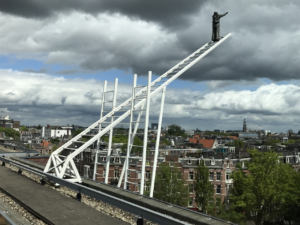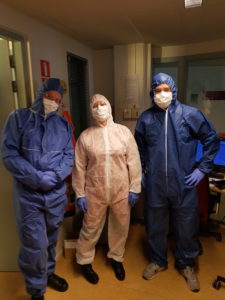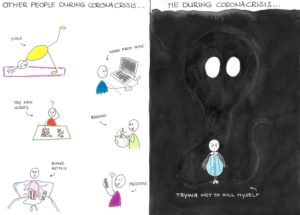(UN)COUPLE
door Remi Walsarie
On the spot where the Pest and Dolhuys used to stand and later the Wilhelmina Gasthuis, there is now a psychiatric center of Mentrum. It is a place where care is provided for many people with psychiatric problems. It houses an admission clinic, day treatment, a crisis service and an outpatient clinic for status holders. The new building in the Eerste Constantijn Huygensstraat stands out because of the sculpture “How to Meet an Angel” by the artists Kabokov (little man on a ladder).
The Corona crisis has also taken us by surprise. The doctors, nurses, psychologists, psychiatrists, therapists, and support staff who work here are not the same as in the ICU’s where the last few months have been fighting for lives. For us, the Corona crisis looks different.
Our task is to treat, protect, support and (again) make people with mental health problems part of society, the city. When the Corona – and therefore far-reaching consequences of a lockdown – presented itself, this raised many questions and had enormous consequences for the care we provide.

The clinic Mentrum 1e Constantijn Huygen street. Also how we should visit patients who have a suspicion of corona.
Clinic:
Within the clinic, we had to think in a very short time about who was allowed to enter the building and how we would deal with new patients who might be infected with the virus. In one department there is a group of often confused people who are not all able to comply with RIVM recommendations. Some people said they didn’t believe in Corona and didn’t want to keep their appointments. It was agreed for the entire clinic that patients were no longer allowed to go outside and receive visits. This was a very difficult decision, which we felt was necessary to keep Corona out of the clinic. Psychiatric patients often have a poorer health and socio-economic status than their peers and therefore run a higher risk of a more serious course of infection. Funnily enough, the admitted patients reacted very well to the strict measures about visiting and going outside. They indicated that it made them feel safe, that it was clear and that it applied to everyone in the building, so it was fair. Of course they also had a hard time with it, but it was wonderfully quiet on the wards. As the lockdown lasted longer, the unrest in the departments increased. In the end we relaxed the visiting arrangements (people are allowed to appoint 1 person to visit), as well as going outside (under the supervision of a nurse).
In the beginning of the crisis, the flow of new people was decreasing. We had expected that there would be more applications, but there were fewer. Our idea was that people were called to account on their common sense and that this prevailed in their acts and omissions, so that they were able to hold their own very well for a few weeks. After about 2-3 weeks, however, a steady stream of new patients came in who had just been psychiatrically disrupted by the crisis. The ‘normal’ disturbances also came in. Approximately 20% of all admissions turned out to be ‘Coronagerelated’. One should think of people who were no longer able to see their outpatients because they were only allowed to make video calls. People who were so stressed by the fear of the virus that they became manic or psychotic, but also people who became suicidal from the situation. In addition, we now see more people who have experienced a Corona infection and have been disrupted by its consequences.
Within the clinic, several people have been ‘suspected’ of Corona to date. Fortunately, we are able to test them quickly. So far, not a single patient has tested positive. Hopefully we can keep that up!
Staff:
Most of the staff had no trouble coming to work. Some of them, for example with an underlying disorder, understand very well that they found it exciting, for them alternative work was sought outside the nursing wards. Luckily, as an inpatient clinic, we always take the risk of infection into account and we have a limited supply of protective equipment for quarantine nursing. This stock was initially too small, we had to prioritize, manage and expand the stock properly. In a short period of time, we described a lot of work instructions and colleagues with hospital experience gave each other instructions in the workplace.
It was nice to see how people are committed to the patients. Because of the measures, group therapies could no longer take place. Creative therapy took place in much smaller groups. One staff member suggested coming to work one day less during the week, but in the weekend. This was greatly appreciated by patients and staff members. Interestingly, some staff members found it very difficult to come to the clinic. Afraid to infect others, or to become infected. In the beginning, colleagues grumble a lot about this. People were looked at in the way they dealt with their fear about the virus. In one of our – initially daily – coronamails to the staff, it was mentioned that everyone deals with their fear differently and that this is a good thing. This helped. When you are anxious yourself, it is much more difficult to get into someone else’s emotions, it is very easy to reject them. This is something that we, working in psychiatry, know best, but also happens to us when the fear of others, loved ones and yourself plays up. In the meantime this has calmed down much more. People come back to work as if it is ‘normal’. While it is still not ordinary.

Actions:
Day treatment:
Day treatment is the part of the treatment that focuses on further recovery, acceptance and participation of patients. It is for people who have been admitted, but also to prevent them from being admitted. The programme consists of many parts that are usually done in groups. Some examples: the day opening, psycho education, sports, creative therapy, mindfulness, cooking, and entering into reintegration trajectories. Because of the Corona and with it the closing of the facilities, the program could no longer be executed on location. Especially the groups were a problem. Soon we started to do a number of parts of the program via video bells. This worked well for some people and not for others. It became clear how difficult it was for patients to sit alone at home and not be able or dare to go outside. People in day care are often just past a serious period. A psychosis, severe depression or an admission. Many of them have a meagre social network and have dropped out of work because of their psychological problems.
By means of video calls we keep in touch with our patients and themselves.
Weekly there is a thematic newsletter in which topics such as suicidality, fear of relapse, changes are discussed. Tips to get through the day, online cultural activities, assignments of the creative therapists are also part of the newsletter.
Fortunately, the relaxation of the rules means that there are more opportunities to see patients again in real life. Parts such as creative therapy and psycho-education are again given in small groups. In this way the day treatment also adapts to this era.
Poli new Amsterdammers:
From here care is provided and directed for status holders with psychological problems. Approximately ten thousand new Amsterdammers live in Amsterdam. Despite the fact that many of them find their way well, it is a vulnerable group. Because of war violence, their flight and the need to function in a new country, in a new culture, this group has more psychiatric problems. A lockdown is also difficult for this group. Sitting at home means a break in their integration because study, work or volunteer work stops. Most of them also have only a limited network and are really locked up at home alone.
What became clear is that social isolation really means loneliness for them. Our care for this group continues. People are spoken twice a week through video calls. Once by the psychologist and once by the psychiatrist. When people really threaten to get into crisis, they are simply invited and seen. Fortunately, we are now set up in such a way that we have more face to face conversations. What remains is that society is almost at a standstill.
It is not the case that everyone is sadly sitting at home right now. Many people are defensible and creative precisely because of what they have experienced. Some of our patients support others, by making art, by having conversations with other vulnerable people.

Drawing by Karin Koole depicting what it feels like to be alone at home these days.
Margje Jalink, Louis of Grastek & Wilco Tuinebreijer
by Margje Jalink, Lodewijk van Grastek & Wilco Tuinebreijer